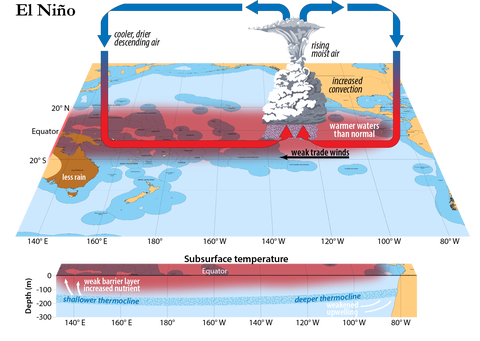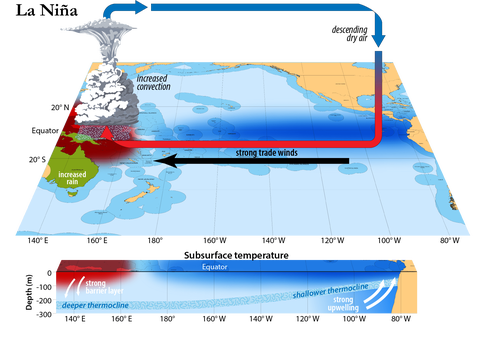Increasing our knowledge of oceanic processes and how they influence fish populations in the Pacific for better fisheries management
Our oceanographic work focuses on how a range of ocean processes, from currents to water temperatures and productivity, combined with climate dynamics influence the movement of tuna and drive change over time. Ocean-climate systems have been shown to strongly influence tuna fisheries in the western and central Pacific Ocean (WCPO) at various spatio-temporal scales and in different ways. Changes in oceanography may influence vertical and horizontal movements of tunas and other species, as well as egg and larval survival. Individual tuna species display different preferences, such as for temperature, and thus will respond differently to changes in oceanography and climate. While beyond the control of fishery managers, it is important to take into account the influence of oceanography and climate in order to better manage fisheries.


The Pacific Ocean has a distinctive thermal structure: there is the “warm pool” in the western equatorial region, and a band of nutrient-enriched cold waters stretching across the eastern and central equatorial region which is known as the “cold tongue”. Globally, tuna catches are highest in the western equatorial Pacific warm pool, a region characterised by low primary productivity and the warmest surface waters of the world’s oceans. However, the WCPO displays remarkable dynamics in oceanography mostly linked to climatic changes (such as El Niño Southern Oscillation, ENSO). In response, variations in tuna catches are reported at both regional and domestic scales both seasonally and inter-annually as tuna movements and distributions are directly impacted by oceanic processes. Increasing our knowledge of these processes and how they change over space and time remains a key issue for fisheries management. Such processes include the divergence or convergence of currents, which can induce physical phenomena such as upwellings, presence of low dissolved oxygen concentration, thermal fronts, and eddies, that enhance local productivity and create zones for foraging, attracting and concentrating the tuna. In particular, east-west migration of the warm pool-cold tongue pelagic ecosystem should be considered carefully by fisheries managers across the region.
ENSO and tuna distribution
Analyses have demonstrated that inter-annual variability in the environmental conditions linked to climatic oscillation (ENSO) is evident in the operation of the main tuna fisheries and the population dynamics of the tuna species. ENSO affects tuna fisheries through environmental changes in the warm pool-cold tongue system. During El Niño conditions, the distribution of purse-seine catch in the western and central Pacific is generally displaced eastwards, indicating a spatial shift in the distribution of tuna. There is an obvious impact for the Pacific Island countries and territories (PICTs) through variations in the level of tuna catches in their Exclusive Economics Zones (EEZs) and consequently on their economical revenue, according to the ENSO situation.
Influence on recruitment
Contraction or extension of the warm pool also has a major impact on tuna recruitment which varies among species. For tropical species, such as skipjack and yellowfin, El Niño events would favour recruitment through the extension of warm water spawning habitats, whereas La Niña events would restrict the favourable spawning areas and reduce recruitment. For subequatorial species, such as South Pacific albacore, the opposite trends are found. Scientists take these phenomena into account to provide some indication of likely future catches within individual EEZs.
Global warming is also likely to affect regional tuna fisheries by raising average sea surface temperature to levels currently experienced during El Niño and by increasing year to year variability. It is also possible that there could be a change in primary productivity in the tropical Pacific. These factors could affect distribution, abundance, and catchability of tuna fisheries, but further investigations are required to validate these assumptions and to develop mitigation strategies for fisheries management.
